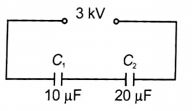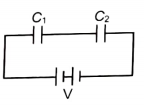Two parallel plate capacitors have their plate areas 100 cm2 and 500 cm2 respectively. If they have the same charge and potential and the distance between the plates of the first capacitor is 0.5 mm, then the distance between the plates of the second capacitor is:
1. 0.10 cm
2. 0.15 cm
3. 0.20 cm
4. 0.25 cm
A dielectric slab of dielectric constant K is placed between the plates of a parallel plate capacitor carrying charge q. The induced charge q' on the surface of the slab is given by:
1.
2.
3.
4.
Two charge capacitors have their outer plates fixed and inner plates connected by a spring of force constant 'k'. The charge on each capacitor is q. Find the extension in the spring at equilibrium

1.
2.
3.
4. Zero
The following arrangement consists of five identical metal plates parallel to each other. The area of such plate is A and separation between the successive plates is d. The capacitance between P and Q is:
1.
2.
3.
4.
A capacitor is half-filled with a dielectric (K=2) as shown in figure A. If the same capacitor is to be filled with the same dielectric as shown in figure B, what would be the thickness of the dielectric so that the capacitor still has the same capacity?

1. 2d/3
2. 3d/2
3. 3d/4
4. 4d/3
Capacitors and are connected in series across a 3 kV supply as shown. What is the charge on the capacitor C1?

1.
2.
3.
4.
The charge on the 6 capacitors in the circuit shown is:
1.
2.
3.
4.
In the circuit below and . If no capacitor can sustain more than 50 V, then the maximum potential difference between X and Y is:

1. 95 V
2. 75 V
3. 150 V
4. 65 V
In the circuit shown below and . If the charge on C1 is then potential difference between X and Y is
1. 2 V
2. 3 V
3. 6 V
4. 3.5 V
In the circuit below, if a dielectric is inserted into C2, then the charge on C1 will:

1. Increase
2. Decrease
3. Remains same
4. Be halved









